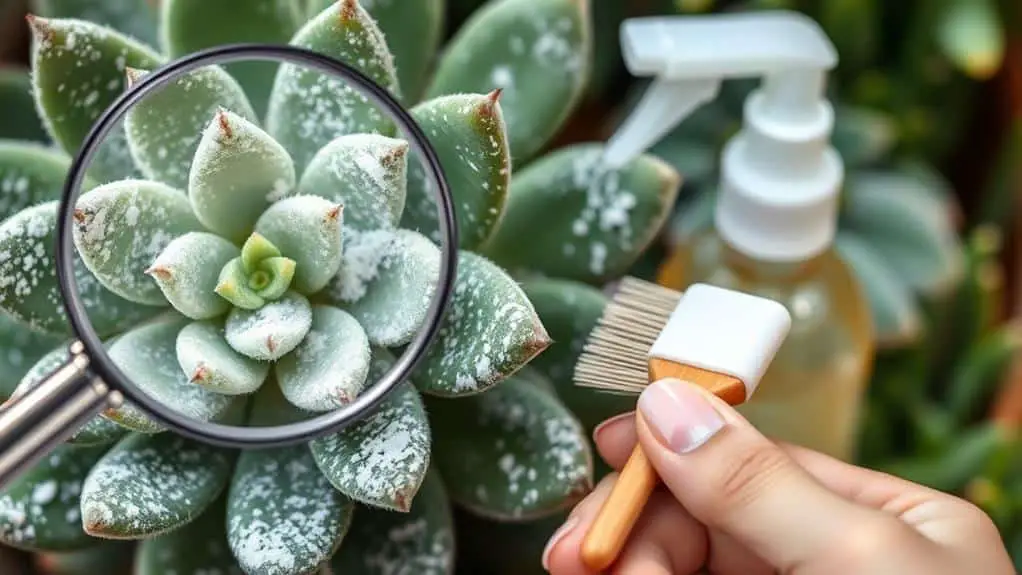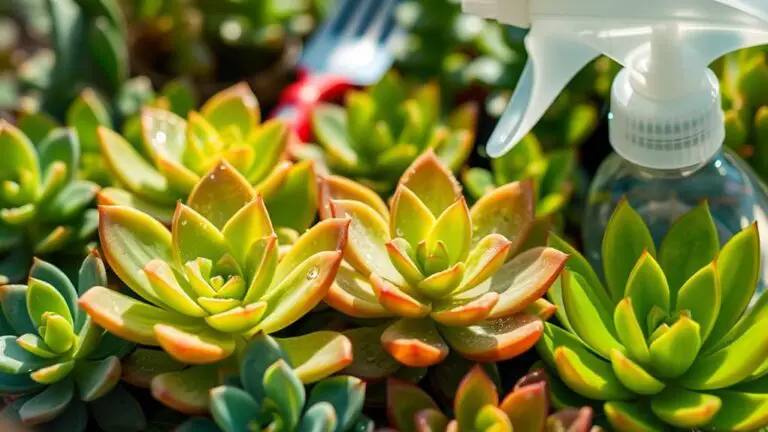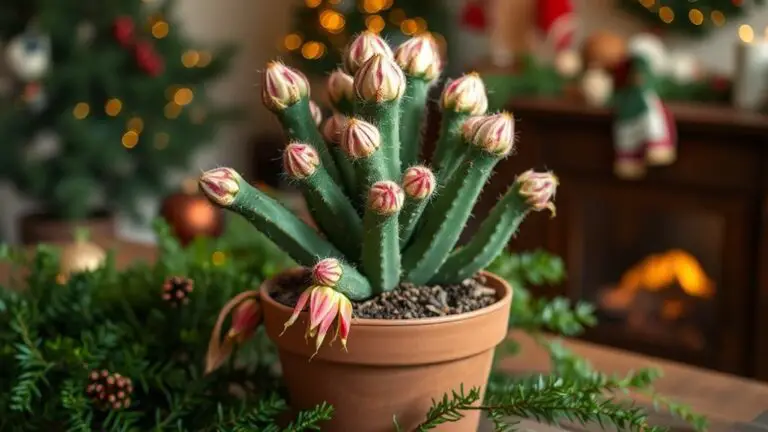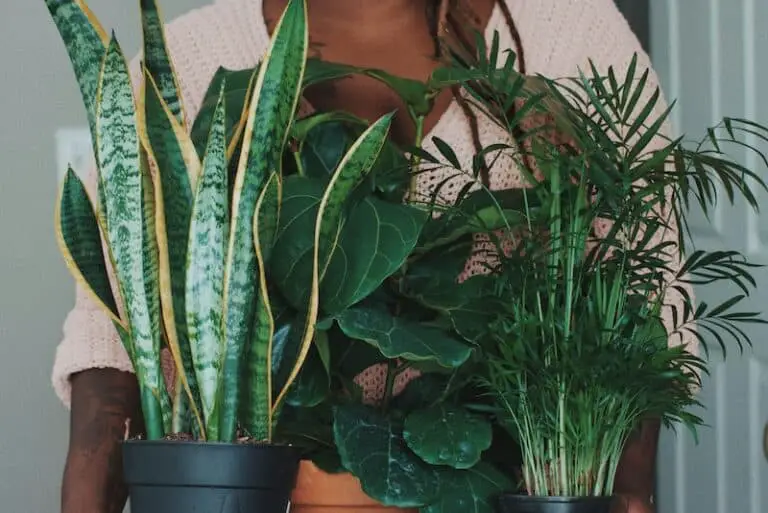How to Identify and Treat White Powder on Succulents
You're tending to your succulents and notice a white, dusty coating on the leaves; it's time to take action. This powdery mildew thrives in warm, humid conditions and can quickly spread if not addressed. Start by isolating the affected plants and removing any infected leaves. But what's the best way to treat and prevent this common issue? Should you opt for organic solutions like neem oil or explore chemical treatments? Understanding the symptoms and immediate actions is essential for maintaining healthy succulents. Let's explore effective strategies for combating and preventing this pesky mildew.
Recognizing Powdery Mildew

Powdery mildew, appearing as a white or grayish powdery coating on succulent leaves, often signals a fungal infection. When you spot this powdery substance, it's vital to take action quickly.
Powdery mildew thrives in warm, humid conditions, especially around 75°F, and prefers dry foliage for attachment. This fungus can spread rapidly, affecting nearby plants if left unchecked.
To recognize powdery mildew, look closely at the affected leaves. You might notice twisted or distorted leaf shapes. Sometimes, there are even scab-like lesions that can vary in color. These signs indicate that your succulent is struggling with this fungal invader.
Checking your plant's environment can also help in identifying powdery mildew. Pay attention to airflow around your plants and the humidity levels in your space. Good airflow and balanced humidity can prevent the mildew from taking hold in the first place.
Early identification is important. The sooner you spot the signs, the better chance you have of saving your plants.
Commonly Affected Succulents

Some succulents are more likely to develop white powder, and recognizing the early symptoms can save your plants.
Echeveria 'Blue Bird', Kalanchoe luciae, and certain jade plants often show white powder due to fungal issues.
Regularly inspect these varieties for any powdery spots, and you'll be better prepared to treat them quickly.
Susceptible Succulent Varieties
Certain succulents, particularly Echeveria, Kalanchoe, and specific Haworthia species, are more vulnerable to white powdery mildew, especially under humid conditions. These susceptible succulent varieties often struggle with this issue due to their dense foliage and the potential for inadequate airflow. Other common varieties like Jade plants and various Cotyledon species also face similar risks.
Environmental factors play a big role in the development of white powdery mildew. Prolonged wet soil and water on the leaves can greatly increase the chances of an infection. It's essential to monitor your plants regularly to catch any early signs of white powder. This can help you prevent severe infestations and potential damage to your succulents.
To help you keep track of which succulents are more prone to white powdery mildew, here's a quick reference table:
| Succulent Variety | Vulnerability Level | Common Conditions |
|---|---|---|
| Echeveria | High | Humid, poor airflow |
| Kalanchoe | High | Humid, wet soil |
| Haworthia species | Medium | Humid, water on leaves |
Maintaining proper spacing and ensuring good airflow around these susceptible succulent varieties is important. By doing so, you can reduce the likelihood of powdery mildew development and keep your plants healthy and vibrant.
Identifying Early Symptoms**
Early symptoms of white powder on succulents are often subtle but vital to spot. If you catch them early, you can save your plants from more serious damage. Commonly affected succulents include Echeveria species, Kalanchoe, and certain types of jade plants.
These plants may show early signs of a fungal disease known as powdery mildew, which thrives in high humidity and poor air circulation.
When inspecting your succulents, look out for:
- Dusty White Spots: These often appear on the leaves and can be mistaken for farina, a natural wax.
- Splotchy Coating: This white, powdery layer can spread quickly if not treated.
- Twisted Leaves and Stunted Growth: These are signs that the infection is advancing.
To prevent powdery mildew, pay close attention to changes in your succulent's appearance. Regularly check the leaves for any white spots or unusual coatings.
Early identification and treatment are essential because powdery mildew can lead to more severe issues like twisted leaves and stunted growth. By catching these symptoms early, you'll keep your succulents healthy and thriving.
Keep your plants in a well-ventilated area and avoid overwatering to reduce the risk of fungal disease.
Symptoms of Infection

When it comes to identifying powdery mildew on succulents, one of the most telling symptoms is the appearance of a white, dusty coating on the leaves. This white powder is actually fungal growth, which can cause significant damage if left untreated. You might also notice that the leaves start to twist or curl, a sign that the plant is struggling to photosynthesize properly due to the fungal infection.
Regularly inspecting your succulents is key. Scab-like lesions may form on the leaves, showing up in colors like white, brown, or rust, depending on the type of succulent you have. These symptoms can be exacerbated by poor airflow and high humidity, both of which create an ideal environment for fungal growth.
Here's a quick reference table for common symptoms:
| Symptom | Description |
|---|---|
| White, dusty coating | Powdery mildew on leaves |
| Twisted or curled leaves | Indication of photosynthesis issues due to infection |
| Scab-like lesions | Lesions in colors ranging from white to brown or rust |
| Poor airflow | Contributing factor to fungal growth |
| High humidity | Creates an environment conducive to powdery mildew |
Immediate Actions

When you spot white powder on your succulents, your first step is to isolate the affected plant to stop any potential spread.
Next, check the leaves carefully to tell if it's powdery mildew or just the plant's natural coating.
If you see infected leaves, remove them right away to help your succulent stay healthy.
Isolate Affected Plants
Discovering white powder on your succulents can be alarming, so it's important to act quickly to protect your green companions. The first step is to isolate affected plants to prevent it from spreading to healthy ones. This immediate action is significant in managing potential infections like powdery mildew.
For container plants, move them away from other plants and place them in a separate location with good airflow to minimize humidity. In garden settings, treat infected plants in place unless the spread is severe, which might require removal to safeguard surrounding flora.
Here's a quick guide to help you:
- Move Container Plants: Relocate affected plants to a different area with good airflow.
- Treat in Place: For garden plants, treat them where they're unless the infection is widespread.
- Remove Affected Foliage: Gently remove infected leaves to reduce the spore load.
Carefully removing any affected foliage can reduce the spore load, but do so gently to avoid shocking the plant.
Monitor the isolated plants closely for any recurrence of the white powder. Early detection is crucial for effective management and treatment, ensuring your succulents remain healthy and vibrant.
Examine Environmental Conditions
To effectively combat the white powder on your succulents, start by examining the environmental conditions surrounding your plants.
First, assess the humidity levels. Succulents thrive in low humidity, so if it's too high, it can create the perfect environment for powdery mildew. You can use a dehumidifier or simply improve ventilation around your plants to help reduce humidity.
Next, verify there's enough space between each plant. Adequate spacing promotes good airflow, which helps keep leaf surfaces dry and prevents fungal infections. If your plants are too close together, consider rearranging them to give each one some breathing room.
Temperature also plays a big role. Powdery mildew prefers warm conditions, around 75°F (24°C). Keep an eye on your indoor temperatures and try to maintain a stable, cooler environment when possible.
Watering practices are vital. Overwatering or letting water sit on the leaves can encourage mildew growth. Make sure you're letting the soil dry out completely between watering sessions and avoid getting the foliage wet.
Lastly, regularly inspect your plants for any signs of stress or disease. Early detection of any issues can lead to quicker and more effective treatments, keeping your succulents healthy and powder-free.
Remove Infected Leaves
After examining the environmental conditions and making necessary adjustments, the next immediate step is to address the infected parts of the plant. Start by isolating the affected succulent to prevent the spread of fungal infections like powdery mildew.
Once isolated, you'll need to carefully remove infected leaves to minimize trauma and avoid introducing more pathogens.
Here's what to do:
- Use clean, sharp scissors: Carefully cut away the infected leaves. This helps to reduce the chance of spreading the fungus to healthy parts of the plant.
- Dispose of the leaves properly: Don't just leave them lying around. Infected leaves can harbor spores that might infect other plants, so throw them in the trash.
- Monitor the plant: After removing the infected leaves, keep an eye on the remaining foliage. Look for signs of new growth or further infection. This way, you can act quickly if needed.
After you've removed the infected leaves, consider applying a fungicide or natural treatment. This helps protect your succulent from future infections and promotes recovery.
Organic Treatment Options
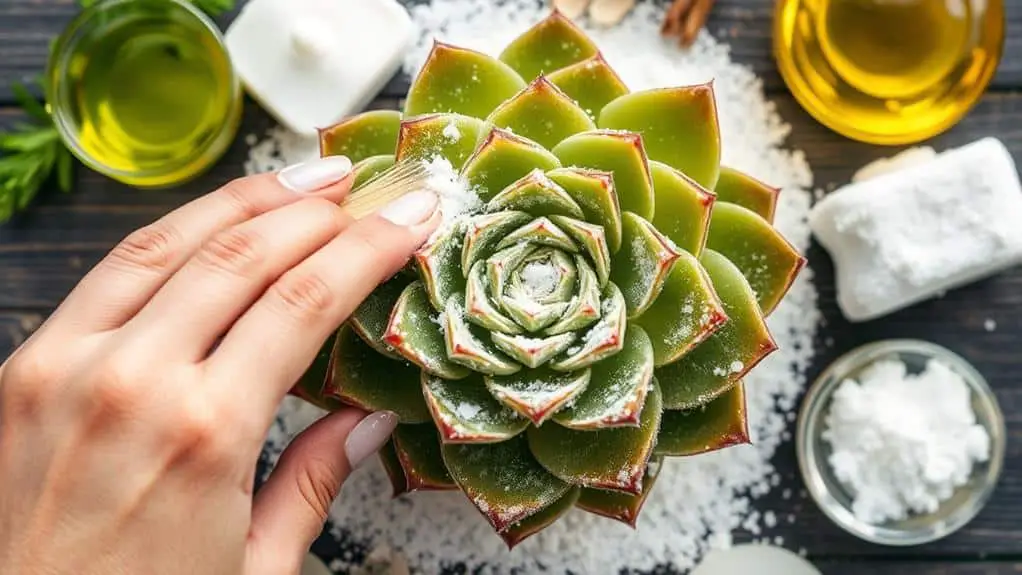
Treating white powdery mildew on succulents organically involves using natural remedies that are both effective and safe for your plants.
First, consider neem oil, which acts as a fungicide and an insect repellent. To use it, dilute the neem oil according to the package instructions and spray it on the infected areas of your succulents. This will help kill the mildew and keep pests away.
Another great option is a baking soda mixture. You can make this by mixing one tablespoon of baking soda with one gallon of water. Spray this solution onto your plants to inhibit fungal growth. Baking soda changes the pH levels on the surface of the leaves, making it hard for mildew to thrive.
Additionally, you can use cinnamon powder as a natural antifungal agent. Simply dust the affected areas with cinnamon to help control the spread of the mildew.
A diluted vinegar solution can also be effective. Mix one part vinegar with three parts water and spray it directly on the infected leaves.
Lastly, essential oils like tea tree oil offer antifungal benefits. Add 10-15 drops of tea tree oil to a liter of water and spray it on the mildew.
Chemical Treatment Methods

When organic methods aren't enough to combat white powdery mildew on your succulents, chemical treatment methods offer a more potent solution. Sometimes, these stronger methods are just what you need to save your affected plant.
- Neem Oil: Neem oil is a natural fungicide that can be diluted and sprayed on your succulent's leaves. Follow the product instructions carefully. It helps limit the spread of powdery mildew and is less harsh than some other treatments.
- Copper Fungicide: For severe infections, a copper fungicide can be very effective. Apply it as soon as you notice the first signs of mildew. Use a low-concentration formula to avoid shocking your plant.
- Sulfur: This is a great option for both controlling and preventing powdery mildew. Make sure to cover all leaf surfaces and reapply every few days until you see improvement.
Additionally, a baking soda solution can serve as a homemade fungicide, and isopropyl alcohol can be applied directly to the mildew spots. Both methods are good for early-stage infections.
Prevention Strategies

Preventing white powdery mildew on your succulents is easier than you might think. Here are some tips to help keep your plants healthy and free of that pesky white powder.
First, verify your succulents have plenty of space. Proper spacing promotes airflow, reducing humidity and making it harder for mildew to take hold. Also, water your succulents only when the soil is completely dry. Overwatering can create a damp environment that's perfect for fungal growth.
Next, sunlight is your friend. Keep your succulents in full sunlight for at least six hours a day. UV exposure helps prevent the onset of powdery mildew. Using well-draining soil mixes and terracotta pots can also make a big difference. These materials help enhance evaporation and prevent water from accumulating around the roots.
Finally, regularly inspect your plants. Early detection of white powder or other abnormalities allows you to act swiftly and prevent the spread.
Here's a summary of these prevention strategies:
| Tip | Benefit |
|---|---|
| Adequate spacing | Enhances airflow, reduces humidity |
| Watering properly | Prevents damp conditions, reduces fungal risk |
| Full sunlight | UV light deters powdery mildew |
| Well-draining soil | Enhances evaporation, prevents water buildup |
Best Practices for Succulent Care

While caring for succulents, it's vital to follow specific best practices to guarantee your plants thrive and remain healthy.
First, make certain you maintain proper watering techniques. Let the soil dry out completely between waterings to reduce the risk of fungal infections like powdery mildew. Overwatering is a common mistake, so it's important to be cautious.
Secondly, take care to make sure your succulents have adequate airflow. Proper spacing and placing them in well-ventilated areas prevent humidity buildup, which can lead to diseases. Good air circulation helps your plants breathe and stay dry.
Lastly, use well-draining soil mixes. Incorporate materials like perlite or sand to enhance drainage and avoid standing water, which can cause root rot.
Here's a quick recap:
- Water Wisely: Allow soil to dry completely between waterings.
- Ensure Airflow: Space plants appropriately and place them in ventilated areas.
- Choose Well-Draining Soil: Use soil mixes with perlite or sand.
Regularly inspect your succulents for early signs of distress or pests. Early detection allows for prompt treatment and minimizes damage.
Also, provide ideal sunlight exposure, as adequate light supports healthy growth and reduces disease likelihood. Following these practices will help your succulents flourish.
Frequently Asked Questions
How to Get Rid of White Powdery Mildew on Succulents?
Isolate the infected succulent immediately. Apply neem oil for minor cases or copper fungicide for severe infections. Remove badly infected leaves and use a baking soda and water solution. Guarantee proper airflow to prevent future issues.
What Is the White Powder Coating on Succulents?
The white powder coating on succulents is called farina. It acts as a natural sunscreen, protecting the plant from UV radiation and reducing the risk of mold. Don't touch the leaves; it helps maintain farina.
What Is the Weird White Stuff on My Succulent?
The weird white stuff on your succulent is likely farina, a natural protective wax. If it's in irregular patches, it's probably powdery mildew, a fungal disease. Check for uniformity to distinguish and take action accordingly.
How Do You Treat White Powder on Plants?
First, isolate the affected plants. Remove severely infected leaves to prevent spread. Apply diluted neem oil to all leaf surfaces, avoiding direct sunlight. For severe cases, use copper fungicide. Guarantee proper airflow and avoid overhead watering to prevent reoccurrence.
Conclusion
You've got this! By recognizing powdery mildew early and taking quick action, you can keep your succulents healthy. Remember to isolate any affected plants, use organic treatments like neem oil, and guarantee good airflow and sunlight. Regular inspections will help you catch any issues before they become big problems. With these steps, your succulents will thrive. Keep up the good work, and don't get discouraged—every gardener faces challenges, and you're doing great!

